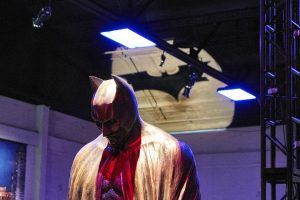One of the oldest recognized superheroes, the Caped Crusader, also has a very long history onscreen, dating all the way back to 1943. The 1943 serial, simply titled Batman, was one of many popular superhero serials of the era, the first time live-action superheroes were depicted on screen. This serial has aged poorly in comparison to later Batman films; the costumes look quite laughable, and neither of the actors playing Batman and Robin performs well in the suits and in the fight scenes. Nonetheless, the serial was influential enough to get reissued in the 1960s, providing the inspiration for the popular Adam West series a couple of years later. Because of this, Batman was largely seen as a "camp" character in mainstream, non-comics depictions throughout the 1960s and 1970s. It would take until 1989, with a visionary young filmmaker named Tim Burton, for a darker Knight to emerge.
In 1989, Warner Bros. released Tim Burton's Batman. The film was stunning, with its Gothic set designs, the memorable music score by Danny Elfman, and great performances by Michael Keaton as Batman and Jack Nicholson as the Joker. It completely dominated the summer financially; perhaps a decade later Hollywood would have been wise enough to use its success as a means to greenlight more superhero films, but this did not come to pass at the time. Audiences did get a sequel to this movie, though by 1992, when Batman Returns was released. The film was chided at the time of its release for being too dark and nihilistic (although Batman stories in the comics had covered similar ground) because comics were still seen as being for children by mainstream critics. The film had a disappointing gross as a result, despite Danny DeVito's and Michelle Pfeiffer's fine performances as Penguin and Catwoman, although audiences respond to it much more positively now.
Sadly, the quality of the series began to decline after Returns. 1995 saw the release of Batman Forever, which actually outperformed Returns by quite a bit but was bland and prosaic rather than being dark and interesting. The film was not helped by "phone it in" performances by Tommy Lee Jones as Two-Face and Val Kilmer as Batman, leaving Jim Carrey's Riddler to provide the film what energy it had. It was followed by Batman and Robin in 1997, a campy mess with ridiculous set designs and costumes and an embarrassed-looking Arnold Schwarzenegger as Mr. Freeze, forced to deliver bad cold-related puns for 2 hours. Batman then took a long break from cinema screens, resurfacing only in 2005.
Christopher Nolan began what would come to be known as the "Dark Knight Trilogy" with Batman Begins, a film very different from prior Batman films. Instead of Gothic or "campy" sets, it was set in realistic locations, with villains who behaved like real gangsters and assassins, and Batman's arsenal was confined to weaponry mostly reproducible as "hard" science fiction. Even Batman's Batmobile was rendered in such a way that it resembled a tank more than a fantastic car! Tightly plotted and featuring actors who actually took the material seriously, the film was a great success, and its plotting stylistics continued with two follow-ups: The Dark Knight, with Heath Ledger as the Joker, and The Dark Knight Rises, with Tom Hardy as Bane. The films as a whole form a tightly woven story of Batman's rise, fall, and redemption and serve as one of the few examples in Hollywood film of a single director staying for the entire series. As a result, they have become acclaimed and are considered among the best superhero films.
Sadly, the quality of Batman films declined once more following the end of Nolan's trilogy. Following the success of the Marvel Cinematic Universe, Warner Bros. made plans to incorporate all of its DC Comics characters into one cinematic continuity. Batman's debut in this series was Batman v Superman: Dawn of Justice. Unlike the earlier Batman Returns and Nolan films, this movie finally DID feature a Dark Knight who was "too dark"- a bloodthirsty vigilante who was willing to attempt to outright murder Superman to preserve order on Earth! The film's extremely violent and "adult" tone didn't actually mean it was intelligent and well-written, as the Batman/Superman conflict was resolved using the stupidest excuse imaginable. The storyline continued with 2017's Justice League, which did feature Batman acting much more in his standard characterization, but the film's muddled tone (thanks to very expensive reshoots) and lack of narrative focus led many to consider it a disappointment. In fact, during this time, the best-received Batman film was actually the direct-to-video animated adaptation of Frank Miller's classic storyline, Batman. This two-part animated film is considered one of the best adaptations of a graphic novel and features great voice work and character designs. Perhaps someday it will see a live-action adaptation, and Warner Bros. will cast Keaton again as the Caped Crusader.


